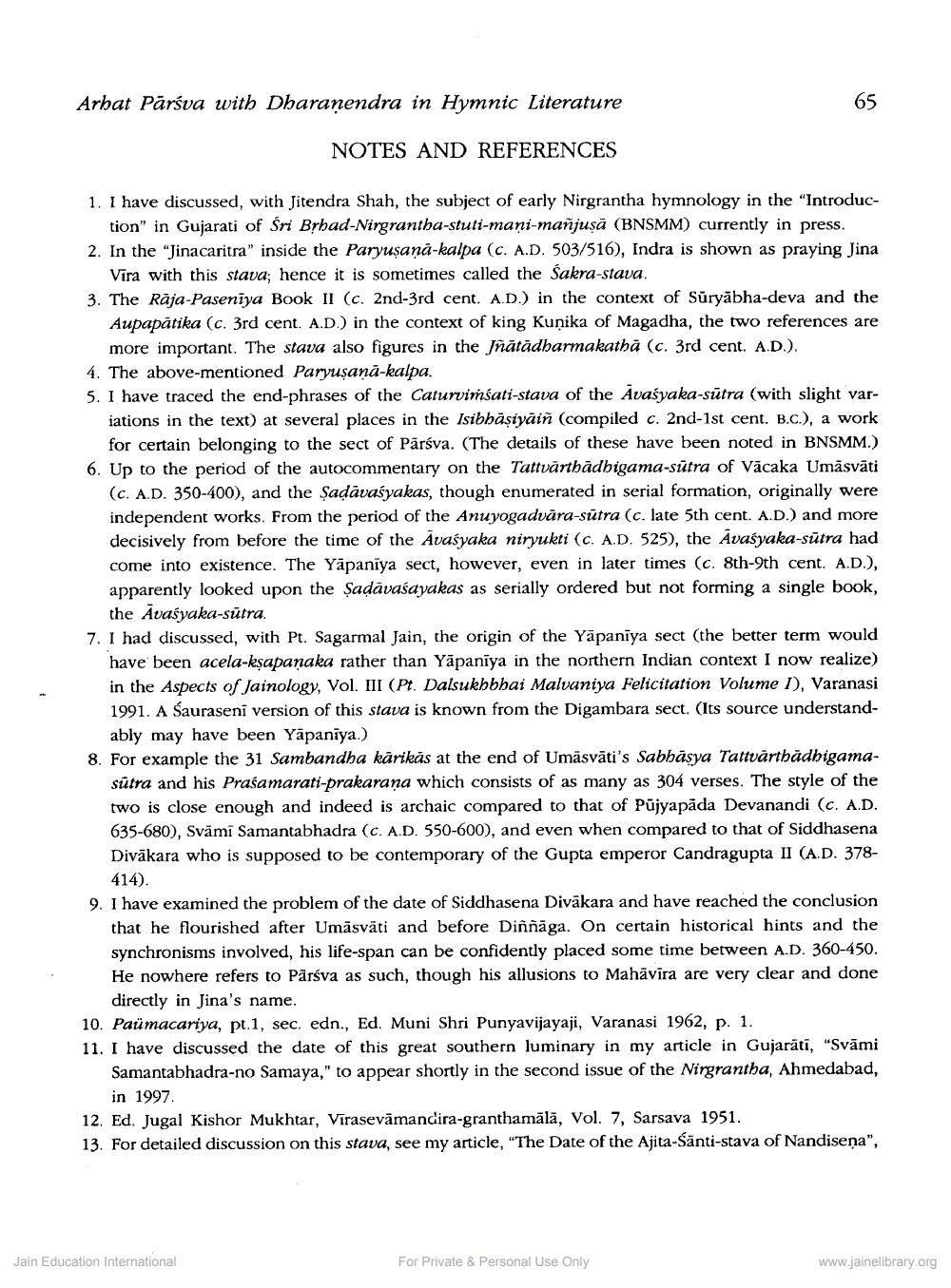________________
Arbat Pārsva with Dharanendra in Hymnic Literature
65
NOTES AND REFERENCES
1. I have discussed, with Jitendra Shah, the subject of early Nirgrantha hymnology in the "Introduc
tion" in Gujarati of Sri Byhad-Nirgrantha-stuti-mani-mañjusā (BNSMM) currently in press. 2. In the "Jinacaritra" inside the Paryusana-kalpa (c. A.D. 503/516), Indra is shown as praying Jina
Vira with this stava; hence it is sometimes called the sakra-stava. 3. The Rāja-Pasenīya Book II (c. 2nd-3rd cent. A.D.) in the context of Suryabha-deva and the
Aupapātika (c. 3rd cent. A.D.) in the context of king Kuņika of Magadha, the two references are
more important. The stava also figures in the Jnātādharmakathā (c. 3rd cent. A.D.). 4. The above-mentioned Paryuşanā-kalpa. 5. I have traced the end-phrases of the Caturvimśati-stava of the Avaśyaka-sūtra (with slight var
iations in the text) at several places in the Isibbasiyāin (compiled c. 2nd-1st cent. B.C.), a work
for certain belonging to the sect of Pārsva. (The details of these have been noted in BNSMM.) 6. Up to the period of the autocommentary on the Tattvārtādhigama-sūtra of Vācaka Umāsvāti
(c. A.D. 350-400), and the Șadāvaśyakas, though enumerated in serial formation, originally were independent works. From the period of the Anuyogadvāra-sūtra (c. late 5th cent. A.D.) and more decisively from before the time of the Avaśyaka niryukti (c. A.D. 525), the Avašyaka-sūtra had come into existence. The Yāpaniya sect, however, even in later times (c. 8th-9th cent. A.D.), apparently looked upon the Șadāvasayakas as serially ordered but not forming a single book,
the Avasyaka-sútra. 7. I had discussed, with Pt. Sagarmal Jain, the origin of the Yāpaniya sect (the better term would
have been acela-kşapanaka rather than Yāpaniya in the northern Indian context I now realize) in the Aspects of Jainology, Vol. III (Pt. Dalsukhbhai Malvaniya Felicitation Volume I), Varanasi 1991. A Sauraseni version of this stava is known from the Digambara sect. (Its source understand
ably may have been Yapaniya.) 8. For example the 31 Sambandha kārikās at the end of Umāsvāti's Sabhāsya Tattvärtbadhigama
sūtra and his Prašamarati-prakarana which consists of as many as 304 verses. The style of the two is close enough and indeed is archaic compared to that of Pujyapada Devanandi (c. A.D. 635-680), Svāmi Samantabhadra (C. A.D. 550-600), and even when compared to that of Siddhasena Divākara who is supposed to be contemporary of the Gupta emperor Candragupta II (A.D. 378
414). 9. I have examined the problem of the date of Siddhasena Divākara and have reached the conclusion
that he flourished after Umāsvāti and before Diññāga. On certain historical hints and the synchronisms involved, his life-span can be confidently placed some time between A.D. 360-450. He nowhere refers to Päráva as such, though his allusions to Mahāvīra are very clear and done
directly in Jina's name. 10. Paümacariya, pt.1, sec. edn., Ed. Muni Shri Punyavijayaji, Varanasi 1962, p. 1. 11. I have discussed the date of this great southern luminary in my article in Gujarati, "Svāmi
Samantabhadra-no Samaya," to appear shortly in the second issue of the Nirgrantha, Ahmedabad,
in 1997 12. Ed. Jugal Kishor Mukhtar, Virasevamandira-granthamālā, Vol. 7, Sarsava 1951. 13. For detailed discussion on this stava, see my article, “The Date of the Ajita-Sänti-stava of Nandisena",
Jain Education International
For Private & Personal Use Only
www.jainelibrary.org




